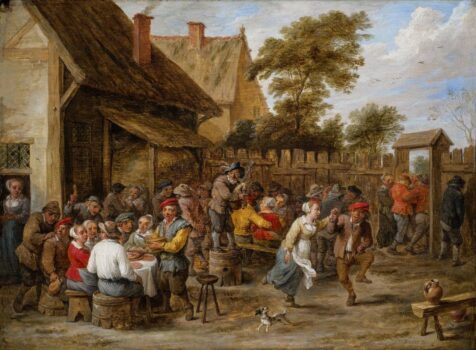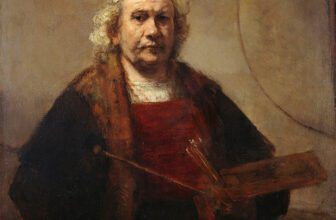Famous Paintings of David Teniers the Younger
In the 17th century, during the height of the Flemish Baroque period, art was not merely decoration, it was a form of storytelling, a way to capture the world in all its splendor and subtlety. Among the giants of this era, Rubens, Van Dyck, and Jordaens, stood a painter whose gift was not in depicting grand mythological battles or sweeping religious epics, but in capturing the intimate, earthy, and often humorous scenes of everyday life. This was David Teniers the Younger (1610–1690), a name that would become synonymous with tavern scenes, peasant festivities, and the charmingly human side of the 17th century.
The Life of David Teniers the Younger
Born in Antwerp in December 1610, David Teniers the Younger was destined for an artistic life. His father, David Teniers the Elder, was himself a painter, and young David began his apprenticeship under him. The elder Teniers specialized in landscapes and small-scale religious works, and while his influence was foundational, David would eventually surpass him in fame.
Teniers’ career took shape in an Antwerp that was still basking in the artistic glow of Peter Paul Rubens. He studied not only with his father but also in the circle of Adriaen Brouwer, whose rustic scenes deeply influenced his early style. This exposure to genre painting, a style focusing on ordinary people engaged in everyday activities, would define Teniers’ artistic trajectory.
In 1637, Teniers married Anna Brueghel, daughter of Jan Brueghel the Elder and granddaughter of Pieter Bruegel the Elder, cementing his connection to one of the most important artistic dynasties in Europe. Through this marriage, Teniers gained not only status but also a direct link to a rich artistic heritage.
By the 1640s, Teniers was a master in the Antwerp Guild of Saint Luke and had begun painting for Archduke Leopold Wilhelm of Austria, the governor of the Spanish Netherlands. His role for the Archduke was both painter and curator, and he was tasked with cataloguing the Archduke’s vast art collection. This work would later result in the publication of the Theatrum Pictorium (Theatre of Painting), the first illustrated catalogue of a major art collection.
What David Teniers the Younger Was Known For
Teniers’ artistic specialty was genre scenes, particularly tavern interiors, village kermesses (fairs), guardroom scenes, and peasant festivities. These works are remarkable for their lively detail, narrative charm, and insight into 17th-century life.
But he was not limited to this, he also painted landscapes, religious works, and portraits. He had a knack for imbuing his subjects with humor and humanity, even when they were of humble origin. Teniers was also one of the first Flemish painters to explore “monkey scenes” (singeries), humorous depictions of monkeys dressed and behaving like humans, a trend that reflected the satirical tastes of the time.
In the court of Archduke Leopold Wilhelm, Teniers gained renown as a painter of gallery interiors, meticulously rendering the Archduke’s art collection within grand architectural settings. These paintings were both documentary and decorative, blending realism with artistic arrangement.
The Most Famous Paintings of David Teniers the Younger
Teniers created hundreds of works, several stand out as masterpieces, both for their artistic merit and historical importance:
“Village Fête” (Kermesse) – This lively outdoor scene depicts peasants dancing, drinking, and celebrating. The work captures the spirit of Flemish village life with warmth and humor.
“The Archduke Leopold Wilhelm in His Gallery” – Perhaps his most historically significant work, this painting shows the Archduke among his vast collection of Italian paintings. It is both a portrait of the collector and a visual record of an important moment in art history.
“The Guardroom” – Teniers painted several guardroom scenes, often filled with soldiers playing cards, drinking, or lounging. These works combine elements of still life, portraiture, and narrative painting.
“The Temptation of Saint Anthony” – Teniers tackled this popular 17th-century subject multiple times. His versions are known for their fantastical creatures and dreamlike landscapes, merging the earthly with the surreal.
“Monkeys in the Kitchen” (Singerie) – A playful scene of monkeys engaging in human activities, painted with exquisite detail and a satirical edge.
“The Smokers” – An intimate tavern interior featuring peasants enjoying their pipes and ale, illuminated with warm, golden light.
The Most Expensive David Teniers the Younger Painting
While the art market fluctuates, one of the most expensive Teniers paintings ever sold at auction is “A Guardroom Interior with Soldiers Playing Cards”, which fetched over $4 million in a 21st-century sale. The value comes not only from its exceptional condition and subject matter but also from its size and the intricacy of its detail.
Other high-value works include his gallery paintings for Archduke Leopold Wilhelm, which are highly prized by museums and collectors for their combination of artistry and documentary significance.
How Many Paintings Did David Teniers the Younger Create?
Teniers was astonishingly prolific. Scholars estimate he produced over 2,000 paintings during his lifetime, though exact numbers are difficult due to attributions, workshop assistance, and copies by other artists. His output was made possible by a disciplined work ethic and a well-organized workshop in Antwerp.
The Storytelling Power of His Work
What makes Teniers remarkable is how his paintings transcend mere representation. A tavern scene is not just a room with drinkers, it’s an unfolding play. The gestures, glances, and subtle interactions between figures draw the viewer into the narrative. His use of light and color creates atmosphere: golden sunlight for outdoor fêtes, warm hearthlight for interior gatherings, and eerie moonlight for his more mystical works.
In a time when art often glorified nobility, religion, or myth, Teniers celebrated ordinary people, peasants, soldiers, craftsmen, without condescension. He painted them with the same care and dignity as more exalted subjects, reflecting a democratic spirit in art.
The Legacy of David Teniers the Younger
Teniers left an enduring mark on European art. His influence extended beyond Flanders into Spain, France, and England. His depictions of peasant life inspired later genre painters in the Netherlands and France, including Jean-Baptiste Greuze and Jean-Baptiste-Siméon Chardin.
His Theatrum Pictorium was revolutionary, it not only documented an important collection but also democratized access to art by reproducing images for a broader audience. This work made him a pioneer in art cataloguing.
Today, Teniers is remembered as a master storyteller in paint, a chronicler of 17th-century life, and an innovator in both subject matter and art presentation.
Where to Find David Teniers the Younger’s Paintings Today
Teniers’ works are held in major museums and collections worldwide. Some notable locations include:
The Prado Museum (Madrid, Spain) – Houses important examples of his guardroom and peasant scenes.
The Louvre (Paris, France) – Includes several fine genre paintings.
The Hermitage Museum (St. Petersburg, Russia) – Features gallery interiors and peasant festivities.
Kunsthistorisches Museum (Vienna, Austria) – Holds The Archduke Leopold Wilhelm in His Gallery and related works.
National Gallery (London, UK) – Displays several of his tavern interiors.
Royal Museums of Fine Arts of Belgium (Brussels, Belgium) – Home to multiple village and festival scenes.
Metropolitan Museum of Art (New York, USA) – Contains guardroom scenes and singeries.
Museo de Bellas Artes (Seville, Spain) – Features religious works.
Private collections also hold significant numbers of his paintings, many of which surface in the auction market.
A Day in the Life of Teniers
Imagine Antwerp in the mid-17th century. The scent of linseed oil hangs in the air as Teniers steps into his studio, sunlight filtering through tall windows. His apprentices are already at work grinding pigments, ochres, lead-tin yellow, and verdigris for greens. On a large oak table sits a half-finished kermesse, the villagers mid-dance, their skirts swirling in invisible music.
A messenger arrives from the Archduke’s palace with a new commission: another gallery painting, this time featuring more of Titian’s works. Teniers nods, he knows these paintings well. He will visit the Archduke’s collection, sketch the Italian masters, and then paint them into the grand interior of the gallery.
Later, after the workday, he might visit a tavern himself, not as a participant in drunken revelry, but as an observer. He watches the card players’ subtle glances, the way the light catches the rim of a pewter jug, the smoke curling from a clay pipe. All of it will find its way onto his canvas.
In his later years, Teniers moved to Brussels and continued to paint, though at a slower pace. His wife Anna had died, and he remarried, but his life remained centered around art. He enjoyed financial success, a testament to his popularity both in Flanders and abroad.
David Teniers the Younger died in Brussels on April 25, 1690, at the age of 79. His reputation never entirely waned, his works continued to be collected, copied, and admired through the centuries.
Why Teniers Still Matters
In a world where art often glorified the extraordinary, David Teniers the Younger found beauty in the ordinary. His paintings invite us into taverns, village squares, and soldiers’ quarters, offering a warm, human, and sometimes humorous window into the past.
More than 300 years after his death, his works still make viewers smile, pause, and look closer, not just at the painted figures, but at the real people they represent. His legacy is one of accessibility, charm, and a deep understanding of human nature.
Teniers reminds us that history is not only the story of kings and battles, it’s also the laughter in a tavern, the music of a village fête, and the shared humanity of everyday life. image/ dejonckheere-gallery




